Ventilation anemostat: design specifics + review of TOP brands on the market
One of the conditions of a comfortable microclimate in the house is sufficient air circulation. Equipping the climate system of the room, it is desirable to provide for the possibility of smooth adjustment of the intensity of air jets.
Anemostats cope with this task. Before choosing an air distributor, you should understand what a ventilation anemostat is and how to choose a model based on specific operating conditions.
These issues have been studied by us and are detailed in the article. In addition to recommendations for selection, we have prepared an overview of popular brands and popular modifications of air vents.
The content of the article:
Use of an anemostat in a ventilation system
Anemostat is the final element of the sensor system, responsible for the uniform distribution of air masses in a closed room. In fact, this is an alternative version of the diffuser or the usual ventilation grill.
The device is actively used in air heating systems, air conditioning and ventilation, both domestic premises and industrial buildings.
The main task of the anemostat is the formation and distribution of airflow entering the room from the outside or vice versa, directed into the exhaust pipe.
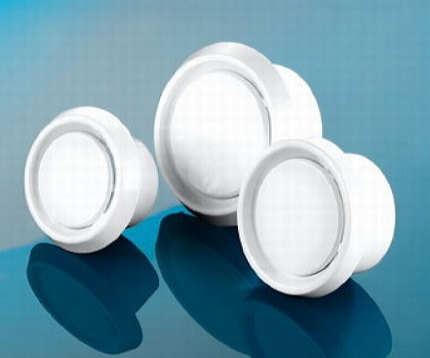
The ceiling is responsible for a number of additional, but no less important functions:
- air volume adjustment;
- elimination of drafts - the device provides aero-convection, due to which the likelihood of air turbulence is leveled;
- effective ventilation of the room - fresh air jets fill the entire interior space of the room;
- overlapping the duct opening.
Some models of air distributors are equipped with a filter element that holds dust particles from the incoming street air.
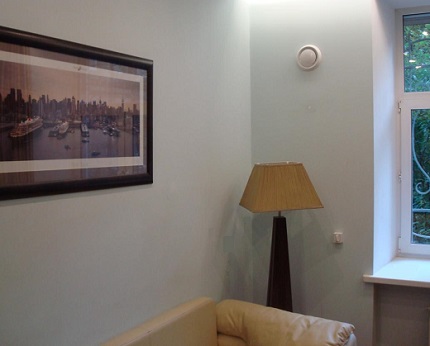
Typical device and principle of operation
The design of the anemostat is extremely simple.
Standard equipment includes:
- round case;
- mounting sleeve;
- flange adjustable partitions;
- threaded rod disc.
A spacer with an adjusting screw and a movable plate is inserted inside the ventilation duct.
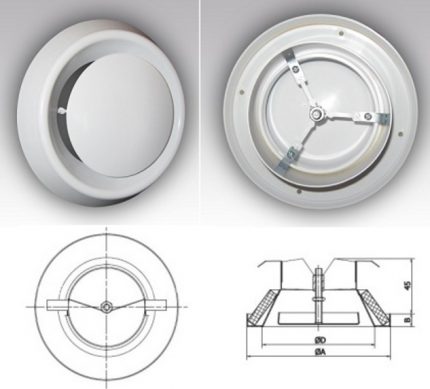
When moving the cover counterclockwise, the through gap increases, respectively, the inflow or outflow of air increases. The permeability of the device increases when the lamp is turned clockwise.
Some anemostats have two plates: one is concave of a larger diameter, the second is of a standard shape. This modification distributes air better.
Design and functional features
Depending on the nature of the distribution and direction of the air jets, three types of anemostats are distinguished: supply, exhaust and universal.
The supply air type distributor is equipped with a shield concave inward. The shape of the plate has minimal aerodynamic drag, so that the air masses are evenly distributed. Such an anemostat is installed in the ducts supply ventilation.
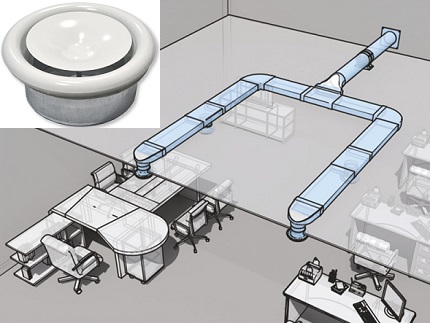
In the exhaust anemostat, the outer cover has a rounded, smooth shape for the effective removal of exhaust air.
The universal supply and exhaust anemostat is equipped with two dissecting caps.
Nuances of using a combined model:
- when mounting in an exhaust system, it is permissible to use simultaneously two slots formed by plates;
- work in the supply ventilation system involves opening one gap created by a concave shield; the exhaust hole in this case must be closed.
The selection of the appropriate mode is carried out manually - the technological gap of the required size is set.
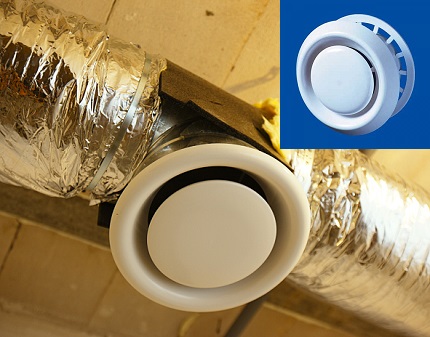
Anemostat and diffuser: similarities and differences
Despite the fact that both devices perform similar tasks, the principle of functioning of the air diffusers varies. The diffuser itself is not designed to control bandwidth.
The angle of inclination of the slats of the supply and exhaust diffuser is fixed, and various modifications of manual control dampers are provided for adjusting the volume of air flow.
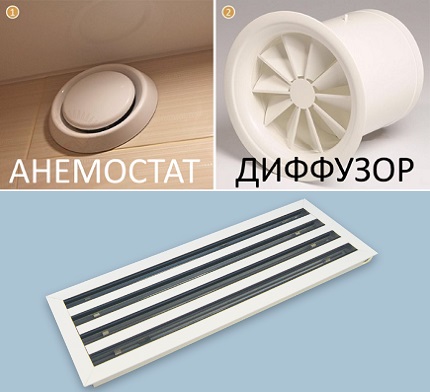
Air Distribution Criteria
The determination of the optimal model of the anemostat should be based on an assessment of a number of parameters: the material of manufacture, the dimensions of the device, the operating range of the plate, and the area of the slot hole. All criteria are selected taking into account operating conditions.
Material of manufacture: which is more practical and durable
Light materials are used in the production: aluminum, plastic or galvanized steel. Exclusive options are made of wood. Each product has its pros and cons.
Metal. A feature of metal products is durability and durability. An additional advantage is a beautiful exterior design that goes well with different styles in the interior.
The disadvantages include: high cost and complicated installation due to the large weight.
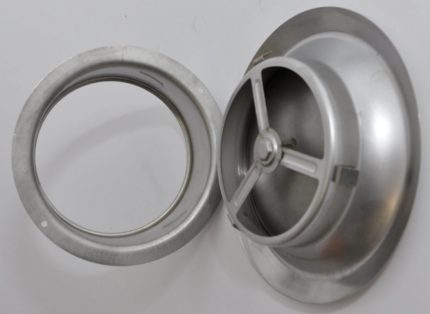
Stainless steel products are installed in baths, saunas or furnace chambers.
Plastic. Plastic anemostats are usually used in household, commercial, office and public buildings. The products worked well in humid rooms (shower, laundry, kitchen, pool, bathroom).
Competitive advantages of polymer anemostats:
- moisture resistance - do not corrode like metal, and do not give in to decay like a tree;
- light weight and ease of installation;
- variety of sizes and colors;
- unpretentiousness in leaving and service;
- low cost.
Negative sides of plastic: low strength and the inability to use hot air masses for “pumping”.
Wood. Such instances are quite rare, they are mainly used if the design of the room requires it. Anemostats look organically in the interior of a wooden house, bathhouse or sauna.

Assessment of the technical characteristics of the anemostat
After choosing the type of distributor (exhaust or supply), evaluating the operating conditions and determining the suitable material, you should choose a model according to three parameters: diameter, size of the slot hole and valve stroke.
Diameter. The cross section of the tip of the anemostat must be compared with the size ventilation system channel. For example, an appropriate 100 mm spreader is suitable for a 100 mm duct.
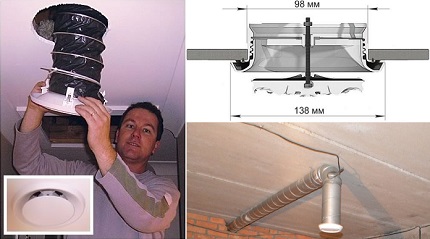
Slot hole. The parameter determines the bandwidth of the device. The run-up of the indicators is the adjustment of the gap using the flange. In small models with a diameter of 80 mm, the boundary living area is 0.002 square meters, in anemostats with a size of 200 mm, the indicator reaches 0.009 square meters.
Power reserve. The indicator characterizes the maximum opening - the movement of the “ceiling” along the normal. The larger the valve stroke, the wider the operating range of the anemostat. The boundary value in different models reaches 8-30 mm.
Type of control ventilation "lampshade"
Most models are designed for mechanical adjustment of the position of the plate. The operating mode of the air distribution valve is set manually - just scroll the “cover” clockwise or vice versa.
In this case, the convenience of control depends on the location of the anemostat. With ceiling mounting, changing the position of the plate is difficult. To simplify the task, it is better to choose an automatic device with a control unit.
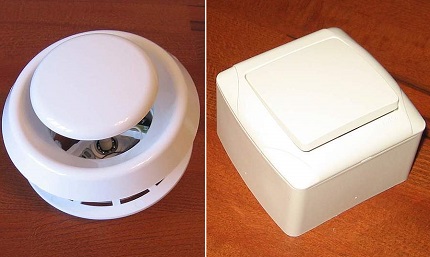
Overview of popular brands and modifications
In the market of ventilation systems, anemostats are represented by various manufacturers. Product Leader Vents. Air distributors are worthy of competition. Dospel, Blauberg, Lessar and Systemair. Consider the proposed modifications of popular manufacturers in more detail.
Vents - a wide range of anemstats
The company sells six series of anemostats:
- A * BP - combined plastic;
- A * VRF - universal with a plastic flange;
- A * OL - supply plastic;
- A * PRF - air inlets with mounting flange, manufacturing material - plastic;
- AM * VRF - universal metal with a flange;
- AM * VRF N - supply and exhaust stainless steel.
The combined A * BP and A * VRF anemostats are made of polystyrene or ABS plastic. Both models are suitable for wall or ceiling mounting.
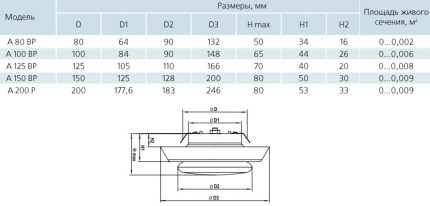
The difference is that A * VRF anemostats are equipped with a flange and a restrictive ring, which make it possible to quickly and easily fix the air distributor in the ventilation duct.
Models A200VR, A200VRF and A200 / 150VRF are equipped with two control elements - this provides a better redistribution of air masses.
Supply air dampers A * PR and A * PRF are available in two diameters: 150 mm, 200 mm.
Corresponding characteristics of air distributors:
- sectional area - 0.011 and 0.012 sq.m;
- the maximum course of the plate along the normal is 21 and 22 mm.
The cost of plastic Vents air distributors without a flange is 4-9 cu, depending on the size and availability of the flange.
The metal models of combined anemostats (AM * VRF and AM * VRF N) are represented by four typical sizes: 100, 125, 150 and 200 mm.
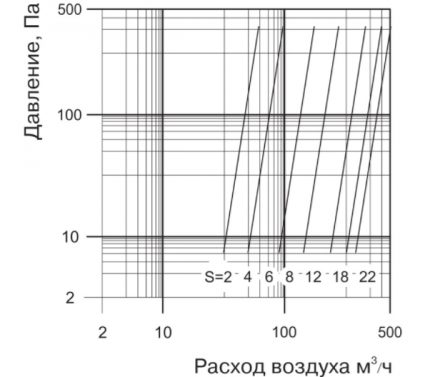
The price for steel products with a polymer layer is 9-12 cu, for stainless steel anemostats - 25-100 cu
Dospel - Polish air distributors
Company Dospel (Poland) specializes in the manufacture of ventilation equipment and accessories.
Air distributors are presented in three subcategories:
- AN * - air inlets made of plastic;
- ANM * EV - exhaust metal anemostats;
- ANM * SV - air inlets made of metal.
The “shades” of the AN series are available in diameters of 100, 125 and 150 mm. The maximum opening of the sash reaches - 16, 13 and 21 mm.

Dospen metal supply and exhaust valves are made of stainless steel and powder coated. Both series (ANM * EV and ANM * SV) are available in five sizes: minimum - 100 mm, maximum - 250 mm.
Estimated cost of plastic models - 4 cu, metal - 6-19 cu
Blauberg: VPR and VMR Series
German corporation Blauberg ventilatoren offers two types of supply and exhaust air distributors:
- Vpr - plastic with mounting flange. They are made of polymers that are resistant to UV rays and temperature influences; antistatic additives are present in the plastic. Overall dimensions are suitable for air ducts of 80-200 mm. The maximum cross-sectional area is 0.009 sq.m.
- VMR - metal anemostats. Production material - steel, on top - a layer of white polymers. The lineup has four positions from 100 to 200 mm.
The high strength characteristics of both models determine their wide scope of application: residential, utility, office, retail premises, kindergartens and medical facilities.

Exhaust and supply air Lessar anemostats
Firm Lessar has production facilities in China and various European countries. The company's products are in demand due to decent quality and affordable prices. Anemostats are available in a limited assortment - metal exhaust and inlet type devices.
Distinctive features of Lessar air distributors:
- the lineup: LV-DCP - for supply ventilation systems, LV-DCV - for exhaust ducts;
- channel section: 100, 125, 160 and 200 mm;
- bandwidth anemostats - 10-500 cubic meters / hour;
- cost - 5-10 cu (depending on the dimensions of the product).
Lessar anemostats are much cheaper compared to similar metal models from other manufacturers.
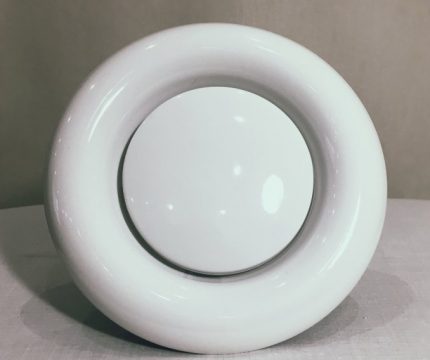
Systemair - European quality ventilation devices
Swedish brand Systemair implements a standardized range of ventilation equipment: fans, air handling units and air distributors.
Types of Systemair air vents:
- Balance-E. Exhaust type device made from regenerated polypropylene. The material stably tolerates high temperature (up to + 100 ° С) and chemical compounds in moderate concentration. Four variations are designed for air ducts of 100, 125, 160 and 200 mm. The maximum air gap is 20 mm.
- Balance-S. Inlet anemostat made of the same plastic as the previous model. Available in three sizes: 100, 125 and 160 mm.
- EFF. A universal steel distributor capable of operating in the "exhaust" and "inflow" of air. EFF modifications have a diameter of 63 to 200 mm, the stroke of the central cone is up to 28 mm.
- TFF Supply air anemostat made of steel. The design includes an inlet cone and a flat soundproofing disc. It is delivered in diameters of 80-200 mm.
Balance-E, Balance-S, and EFF models are installed via a mounting ring or directly into the duct. The TFF is fixed in the ventilation duct with spacer springs or in the mounting frame.
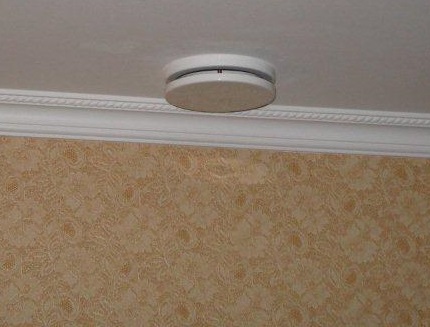
Conclusions and useful video on the topic
A typical device of a universal adjustable "diffuser":
Automatic anemostat operation:
Installation technology of an air distributor in a drywall box:
Anemostat is a simple and effective solution to improve the microclimate. The device is responsible for the uniform flow of fresh air in the discharge ventilation system and regulates the discharge of “exhaust” in the exhaust ducts. An important plus of the air distributor is the affordable cost.
Looking for an effective air vent? Or have experience using such installations? Please leave comments on the article, participate in discussions and share your impressions of using anemostats.

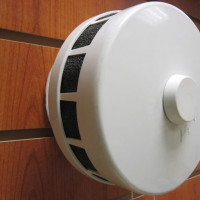 Which supply valve to choose: varieties of valves, features of choice + overview of the best brands
Which supply valve to choose: varieties of valves, features of choice + overview of the best brands  Ventilation deflector: device, varieties, installation rules
Ventilation deflector: device, varieties, installation rules 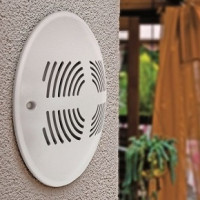 Supply ventilation valve into the wall: features of the arrangement
Supply ventilation valve into the wall: features of the arrangement 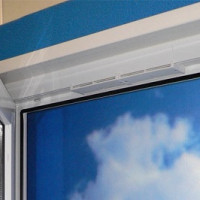 Supply valve on plastic windows: how to choose and install a ventilation valve
Supply valve on plastic windows: how to choose and install a ventilation valve 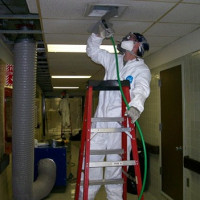 Equipment for cleaning ventilation: varieties + how to choose the best on the market
Equipment for cleaning ventilation: varieties + how to choose the best on the market 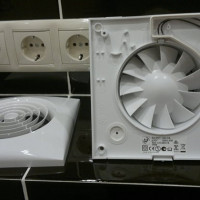 Exhaust fan in the bathroom: tips for customers + ten of the best offers on the market
Exhaust fan in the bathroom: tips for customers + ten of the best offers on the market  How much does it cost to connect gas to a private house: the price of organizing gas supply
How much does it cost to connect gas to a private house: the price of organizing gas supply  The best washing machines with dryer: model rating and customer tips
The best washing machines with dryer: model rating and customer tips  What is the color temperature of light and the nuances of choosing the temperature of the lamps to suit your needs
What is the color temperature of light and the nuances of choosing the temperature of the lamps to suit your needs  Replacement of a geyser in an apartment: replacement paperwork + basic norms and requirements
Replacement of a geyser in an apartment: replacement paperwork + basic norms and requirements